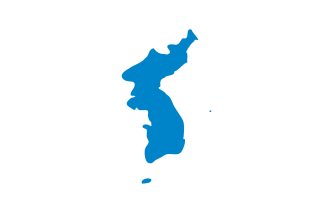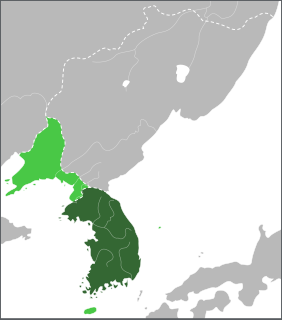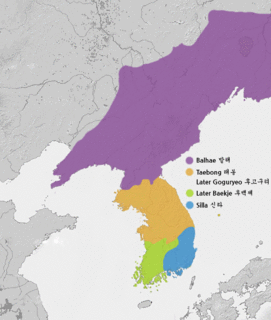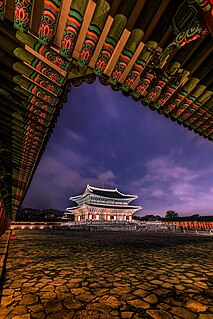See also
- Index of North Korea–related articles
- Index of South Korea–related articles
- Lists of country-related topics - similar lists for other countries
This article is being considered for deletion in accordance with Wikipedia's deletion policy. Please share your thoughts on the matter at this article's deletion discussion page. |
This is a list of articles on Korea-related people, places, things, and concepts. For help on how to use this list, see the introduction below.
You can help keep this list up to date by adding titles of new or existing articles which are not yet listed here. (Before you add an article, however, please consult the Korean naming conventions.)
This is an alphabetical list. For a categorical organization of Korean topics, please see the Categories section below.
For help, please see Naming conventions at the bottom of this page.
To browse this category tree, start at Category:Korea.
1: 1988 Summer Olympics - 1988 Summer Olympics events - 2002 FIFA World Cup - 2002 FIFA World Cup group stages - 2002 FIFA World Cup players - 2002 FIFA World Cup qualification
A: Advertising agencies of South Korea - Aircraft manufacturers of South Korea - Airlines of North Korea - Airlines of South Korea - Airports in North Korea - Airports in South Korea - Albums by South Korean artists - Archaeological sites in Korea - Arts in Korea - Astronomical observatories in South Korea - Astronomy in Korea - Athletics venues in South Korea - Automotive companies of South Korea
B: Baekje - Baekje rulers - Balhae - Balhae rulers - Banks of South Korea - Baseball in South Korea - Baseball teams in South Korea - Baseball venues in South Korea - Battles involving Korea - Battles of the Japanese invasions of Korea (1592–1598) - Battles of the Korean War - Battles of the Russo-Japanese War - Beaches of South Korea - Beer and breweries in South Korea - BoA albums - Bohai - Book publishing companies of South Korea - Books about Korea - Bookstores of Korea - Bridges in North Korea - Bridges in South Korea - British expatriates in Korea - Buddhism in Korea - Buddhist temples in North Korea - Buddhist temples in South Korea - Buildings and structures in Korea - Buildings and structures in North Korea - Buildings and structures in Seoul - Buildings and structures in South Korea - Bundang - Busan - Busan subway lines
C: Catering and food service companies of South Korea - Cathedrals in South Korea - Cemeteries in South Korea - Chaebols - Chemical companies of South Korea - Chinese constellations - Christianity in Korea - Christianity in South Korea - Chungcheongbuk-do - Chungcheongnam-do - Churches in South Korea - Cinema of Korea - CJ Group - Clothing brands of South Korea - Clothing companies of South Korea - Communications in Korea - Communications in North Korea - Communications in South Korea - Companies listed on KOSDAQ - Companies listed on the Korea Stock Exchange - Companies of Korea - Companies of North Korea - Companies of South Korea - Construction and civil engineering companies of South Korea - Cosmetics companies of South Korea - Currencies of Korea - Cycle manufacturers of South Korea
D: Daegu - Daejeon - Dams in South Korea - Disasters in South Korea - Doosan Group
E: Early Korean history - Economy of Korea - Economy of North Korea - Economy of South Korea - Education in Korea - Education in North Korea - Education in Seoul - Education in South Korea - Education in the Joseon Dynasty - Elections in Korea - Elections in North Korea - Elections in South Korea - Electronics companies of South Korea - Engineering companies of South Korea - Entertainment companies of South Korea - Environment of Korea - Expatriates in Korea
F: Fast-food chains of South Korea - Fauna of Korea - Fictional Korean people - Financial services companies of South Korea - Food and drink companies of South Korea - Food manufacturers of South Korea - Football in North Korea - Football in South Korea - Football competitions in South Korea - Football venues in North Korea - Football venues in South Korea - Foreign relations of North Korea - Foreign relations of South Korea
G: Galloper vehicles - GamePark - Gangwon - Gaya - Gaya rulers - Geography of Korea - Geography of North Korea - Geography of Seoul - Geography of South Korea - Goguryeo - Goguryeo rulers - Golf in South Korea - Golf tournaments in South Korea - Goryeo - Goryeo people - Goryeo rulers - Government of North Korea - Government of South Korea - Gwacheon - Gwangju - Gyeonggi - Gyeongsangbuk-do - Gyeongsangnam-do
H: Hanmi Bank - Hangul - Hanja - Health in Korea - Health in South Korea - High schools in Korea - High schools in South Korea - Historians of Korea - History of Korea - History of North Korea - History of Seoul - History of South Korea - Hotels in North Korea - House of Yi - Houses in South Korea - Hyundai - Hyundai engines - Hyundai Kia Automotive Group - Hyundai vehicles - Ice hockey in South Korea
I: Ilyang Logistics - Incheon - Insurance companies of South Korea - International sports competitions hosted by South Korea - Internet companies of South Korea - Islands of Korea - Islands of South Korea
J: Japanese invasions of Korea (1592–1598) - Japanese-Korean relations - Jeju-do - Jeollanam-do - Jeonju Hanok Village - Jeung San Do - Joseon Dynasty - Joseon people - Joseon rulers
K: Kia - Kia vehicles - Korea under Japanese rule - - Korean actors - American writers of Korean descent - Korean Americans - Korean anarchists - Korean animation - Korean animation studios - Korean animators - Korean archaeology - Korean architecture - Korean art - Korean artists - Korean athletes - Korean Bell of Friendship - Korean books - Korean boxers - Korean businesspeople - Korean Canadians - Korean classical pianists - Korean clergy - Korean clothing - Korean composers - Korean Confucianism - Korean Cosmetics brands - Korean cuisine - Korean culture - Korean drinks - Korean film directors - Korean films - Korean generals - Korean hip hop groups - Korean hip hop musicians - Korean history stubs - Korean language - Korean-language names - Korean literature - Korean martial arts - Korean migration - Korean music - Korean musical groups - Korean musicians - Korean mythology - Korean novels - Korean organisations - Korean painters - Korean people - Korean people by ethnic or national origin - Korean people by occupation - Korean philanthropists - Korean philosophers - Korean philosophy - Korean physicians - Korean pianists - Korean poetry - Korean poets - Korean politicians - Korean pop singers - Korean pottery - Korean priests - Korean rock music groups - Korean Roman Catholic priests - Korean royalty - Korean rulers - Korean saints - Korean sculptors - Korean singers - Korean society - Korean sportspeople - Korean studies - Korean styles of music - Korean swords - Korean violinists - Korean War - Korean War aircraft carriers of the United States - Korean War battleships of the United States - Korean War cruisers - Korean War destroyers - Korean War films - Korean War flying aces - Korean War ships - Korean War ships of the United Kingdom - Korean War ships of the United States - Korean words and phrases - Korean writers - Korean writing system - Korean-language films - Korea-related lists - Koreatowns - K-pop - Kumho Asiana Group - Kwangwoon University
L: Lakes of Korea - Lakes of South Korea - Languages of Korea - Languages of North Korea - Law enforcement in South Korea - Lee Jung Hyun albums - LG Group - Lotte
M: M*A*S*H - M*A*S*H (TV series) episodes - Magazines published in North Korea - Magazines published in South Korea - Manhwa - Manhwa distributors - Manufacturing companies of South Korea - Mass media in Korea - Mass media in North Korea - Mass media companies of South Korea - Metropolitan areas of South Korea - Military aircraft of the Korean War - Military history of Korea - Military history of Korea during World War II - Military history of North Korea - Military history of South Korea - Military of Korea - Military of North Korea - Military of South Korea - Military personnel of the Korean War - Military ranks of North Korea - Military ranks of South Korea - Modern weapons of South Korea - Monuments and memorials in South Korea - Mosques in South Korea - Mountain passes of Korea - Mountain ranges of Korea - Mountains of Korea - Mountains of North Korea - Mountains of South Korea - Munhwa Broadcasting Corporation - Museums in North Korea - Museums in South Korea
N: National parks of South Korea - National symbols of North Korea - National Treasures of North Korea - National Treasures of South Korea - Nature conservation in Korea - Nature conservation in South Korea - Naval battles of the Japanese invasions of Korea (1592–1598) - Neighbourhoods of Seoul - Newspapers published in North Korea - North Jeolla - North Korea - North Korea at the Olympics - North Korean actors - North Korean architecture - North Korean boxers - North Korean culture - North Korean diplomats - North Korean figure skaters - North Korean footballers - North Korean gymnasts - North Korean military personnel - North Korean music - North Korean musicians - North Korean people - North Korean people by occupation - North Korean politicians - North Korean society - North Korean speed skaters - North Korean sport shooters - North Korean sport wrestlers - North Korean sportspeople - North Korean weightlifters - Nursing schools in South Korea
O: Oil companies of South Korea - Olympic competitors for North Korea - Olympic competitors for South Korea - Olympic tennis players of South Korea - On-Media - Organizations based in Seoul - Organizations based in South Korea - Organizations based in North Korea
P: Palaces in South Korea - Pansori - Parks in South Korea - People of Korean descent - Pizza chains of South Korea - Poch'ongyo - Political parties in North Korea - Political parties in South Korea - Politics of Korea - Politics of North Korea - Politics of South Korea - Populated places in Korea - Populated places in North Korea - Populated places in South Korea - Ports and harbours of South Korea - Presidents of South Korea - Provinces of South Korea - Pyongyang
R: Rail transport in South Korea - Railway stations in South Korea - Religion in Korea - Religion in North Korea - Religion in Seoul - Religion in South Korea - Religious buildings and structures in North Korea - Religious buildings and structures in South Korea - Republic of Korea Air Force - Republic of Korea Navy - Retail companies of South Korea - Rivers of Korea - Rivers of North Korea - Rivers of South Korea - Roads in South Korea - Roman Catholic Church in Korea - Royal residences in South Korea - Russo-Japanese War
S: - Samsung Group - Samsung mobile phones - Samsung products - Schools in Korea - Schools in North Korea - Schools in South Korea - Medical schools in South Korea - Science and technology in Korea - Science and technology in North Korea - Science and technology in South Korea - Seoul - Culture of Seoul - Seoul subway lines - Seoul subway stations - Service companies of South Korea - Shipbuilding companies of South Korea - Shipping companies of South Korea - Ships of South Korea - Ships of the Republic of Korea Navy - Shopping malls in South Korea - Silla - Silla people - Silla rulers - Ski areas and resorts in South Korea - Skyscrapers in North Korea - Skyscrapers in South Korea - Software companies of South Korea - South Korea - South Korea at the Olympics - South Korean academics - South Korean activists - South Korean actors - South Korean archers - South Korean artists - South Korean athletes - South Korean badminton players - South Korean baseball players - South Korean basketball players - South Korean boxers - South Korean businesspeople - South Korean computer programmers - South Korean culture - South Korean diplomats - South Korean esports players - South Korean figure skaters - South Korean film directors - South Korean football clubs - South Korean football managers - South Korean football squad templates - South Korean footballers - South Korean footballers - South Korean Go players - South Korean golfers - South Korean gymnasts - South Korean health workers - South Korean hip hop - South Korean historians - South Korean kickboxers - South Korean law - South Korean martial artists - Media in South Korea - South Korean military personnel - South Korean ministers - South Korean mixed martial artists - South Korean models - South Korean musicians - South Korean novelists - South Korean people - South Korean people by occupation - South Korean physicians - South Korean pianists - South Korean poets - South Korean politicians - South Korean pool players - South Korean religious leaders - South Korean scientists - South Korean singers - South Korean society - South Korean songs - South Korean speed skaters - South Korean sport wrestlers - South Korean sportspeople - South Korean sportspeople - South Korean table tennis players - South Korean taekwondo practitioners - South Korean television drama - South Korean television series - South Korean tennis players - South Korean theologians - South Korean voice actors - South Korean weightlifters - Special forces of South Korea - Sport in Korea - Sport in North Korea - Sport in Seoul - Sport in South Korea - Sports venues in North Korea - Sports venues in South Korea - StarCraft - Steel companies of South Korea - Streets in Seoul - Subdivisions of South Korea
T: Taekwondo - Taekwondo practitioners — TangSooDo ITF NAM — Television in Korea - Television in North Korea - Television in South Korea - Tofu - Tongyang Orion Group - Tourism in Korea - Tourism in North Korea - Tourism in South Korea - Tourist attractions in Seoul - Tourist attractions in South Korea - Towers in North Korea - Towers in South Korea - Trade unions in North Korea - Trade unions in South Korea - Transport in Korea - Transport in North Korea - Transport in Seoul - Transport in South Korea - Transport operators of South Korea - Typhoons in South Korea
U: Ulsan - Unification Church - United States military in South Korea - Universities and colleges in Seoul - Universities and colleges in South Korea - Universities in North Korea
V: Vocational education in South Korea - Volcanoes of North Korea - Volcanoes of South Korea
W: Wars involving Korea - Water transport in North Korea - Water transport in South Korea - Weapons of Korea - World Heritage Sites in North Korea - World Heritage Sites in South Korea

The history of Asia can be seen as the collective history of several distinct peripheral coastal regions such as East Asia, South Asia, Southeast Asia and the Middle East linked by the interior mass of the Eurasian steppe. See History of the Middle East and Outline of South Asian history for further details.

Korea is a region in East Asia. Since 1945, it has been divided between two countries at or near the 38th parallel, North Korea and South Korea. Korea consists of the Korean Peninsula, Jeju Island, and several minor islands near the peninsula. It is bordered by China to the northwest and Russia to the northeast. It is separated from Japan to the east by the Korea Strait and the Sea of Japan.

The Lower Paleolithic era in the Korean Peninsula and Manchuria began roughly half a million years ago. The earliest known Korean pottery dates to around 8000 BC, and the Neolithic period began after 6000 BC, followed by the Bronze Age by 2000 BC, and the Iron Age around 700 BC.
Korea's provinces have been the primary administrative division of Korea since the mid Goryeo dynasty in the early 11th century, and were preceded by provincial-level divisions dating back to Unified Silla, in the late 7th century.

Goryeo was a Korean dynastic kingdom founded in 918, during a time of national division called the Later Three Kingdoms period, that unified and ruled the Korean Peninsula until 1392. Goryeo achieved what has been called a "true national unification" by Korean historians as it not only unified the Later Three Kingdoms but also incorporated much of the ruling class of the northern kingdom of Balhae, who had origins in Goguryeo of the earlier Three Kingdoms of Korea. The name "Korea" is derived from the name of Goryeo, also spelled Koryŏ, which was first used in the early 5th century by Goguryeo.

Samhan or the Three Kingdoms of Korea refers to the three kingdoms of Goguryeo, Baekje, and Silla. Goguryeo was later known as Goryeo, from which the modern name Korea is derived. The Three Kingdoms period is defined as being from 57 BC to 668 AD.

Jeonju is the 16th largest city in South Korea and the capital of North Jeolla Province. It is both urban and rural due to the closeness of Wanju County which almost entirely surrounds Jeonju. The name Jeonju literally means "Perfect Region". It is an important tourist center famous for Korean food, historic buildings, sports activities, and innovative festivals.

Unified Silla or Later Silla is the name often applied to the Korean kingdom of Silla, one of the Three Kingdoms of Korea, after it conquered Baekje and Goguryeo in the 7th century, unifying the central and southern regions of the Korean peninsula.

The Later Three Kingdoms period of ancient Korea saw a partial revival of the old three kingdoms which had dominated the peninsula from the 1st century BCE to the 7th century AD. After the Unified Silla kingdom had ruled Korea alone from 668 CE, it slowly began to decline and the power vacuum this created led to several rebellious states rising up and taking on the old historical names of Korea's ancient kingdoms. A messy period of alliances and in-fighting followed, but one state would once again establish a dominant position – Goryeo, itself named in homage to the earlier northern Goguryeo kingdom – and form a unified Korean state and a dynasty which would last for over 500 years.

Hubaekje or Later Baekje was one of the Later Three Kingdoms of Korea, along with Hugoguryeo and Silla. Later Baekje was a Korean dynastic kingdom founded by the disaffected Silla general Gyeon Hwon in 900, whom led the local gentry and populace that were in large Baekje descent holding onto their collective consciousness until the twilight days of Later Silla. With the former Silla general declaring the revival of the Baekje kingdom of old, the Baekje refugees from the old territories and a portion of the Rank Six Nobility from Silla seeking the opportunity of rising up the ranks gathered under his leadership. Led by the charismatic and capable Gyeon Hwon who was also a competent field commander, Later Baekje in its early days was advantageous in the power game against the newly found kingdom Goryeo and the declining Silla. However, despite its fertile territories in the Jeolla Province and capable military prowess, it eventually fell to Wang Geon's Goryeo army in 936 due to political strife and Gyeon Hwon's defection towards Goryeo. Its capital was at Jeonju, in present-day North Jeolla province.

Korean architecture refers to an architectural style that developed over centuries in Korea. Throughout the history of Korea, various kingdoms and royal dynasties have developed a unique style of architecture with influences from Buddhism and Korean Confucianism.

Korea's military history spans thousands of years, beginning with the ancient nation of Gojoseon and continuing into the present day with the countries of North Korea and South Korea, and is notable for its many successful triumphs over invaders. Throughout its history, Korea has boasted numerous exceptional leaders who gained outstanding victories against numerically superior enemies. Famed leaders credited with defending Korea against foreign invasions include: Eulji Mundeok of Goguryeo, who defeated Sui China during the Goguryeo–Sui War; Yeon Gaesomun of Goguryeo, who defeated Emperor Taizong of Tang China during the Goguryeo–Tang War; Gang Gam-chan of Goryeo, who defeated the Khitan Empire during the Goryeo-Khitan War; Choe Yeong and Yi Seong-gye of Goryeo, who defeated the Red Turbans, who later established Ming China, during the Red Turban Invasions; and Yi Sun-shin of Joseon, who defeated the Japanese at sea during the Imjin War. Other notable leaders include: Gwanggaeto the Great of Goguryeo, who created a great empire in Northeast Asia through conquest, and subjugated the other Korean kingdoms of Baekje, Silla and Gaya to bring about a brief unification of the Three Kingdoms of Korea; Geunchogo of Baekje, who captured Pyongyang and established overseas territories to control much of the Korean peninsula and dominate the seas; Munmu and Kim Yu-sin of Silla, who united the Three Kingdoms of Korea and defeated Tang China to gain complete control of the Korean peninsula; Dae Jo-yeong, who created Balhae from Goguryeo's ashes and reconquered Goguryeo lands lost during the Goguryeo-Tang War; Jang Bogo of Later Silla, who created a maritime empire and commanded a powerful fleet; Wang Geon, who united the Later Three Kingdoms of Korea and established Goryeo as the successor to Goguryeo; and Yun Gwan of Goryeo, who defeated the Jurchens and constructed nine fortresses in Manchuria.

This is a timeline of the history of Korea. Some dates prior to the 5th century are speculative or approximate.
This is a partial index of Korea-related articles beginning with H.
This is a partial index of Korea-related articles beginning with S.

The National Museum of Korea is the flagship museum of Korean history and art in South Korea and is the cultural organization that represents Korea. Since its establishment in 1945, the museum has been committed to various studies and research activities in the fields of archaeology, history, and art, continuously developing a variety of exhibitions and education programs.

The Northern and Southern States period is the period in Korean history when Unified Silla and Balhae coexisted in the south and north of the peninsula, respectively.

Korea has had a number of capitals. Korea is a peninsula in East Asia, currently the peninsula is divided into two countries: North Korea's capital is Pyongyang, and South Korea's capital is Seoul.
The Goguryeo controversies are disputes between China and Korea on the history of Goguryeo, an ancient kingdom 1/3 located in present-day Northeast China and 2/3 in the Korean Peninsula. At the heart of the Goguryeo controversy is which part of history the kingdom belongs to. Korean scholars have the viewpoint that Goguryeo is part of Korean history alone.
Imperial titles were used in various historical Korean states before the 14th century and at the turn of the 20th century. Early Korean states used "great king", "greatest king", and "holy king"; later Korean states used "emperor". Korean monarchs who used imperial titles had political and religious authority over a realm or domain. The Chinese concept of tianxia, pronounced "cheonha" in Korean, was variously adopted and adapted to Korean views of the world from period to period.